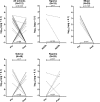Reduced efficacy of albendazole against Ascaris lumbricoides in Rwandan schoolchildren
- PMID: 28697451
- PMCID: PMC5503839
- DOI: 10.1016/j.ijpddr.2017.06.001
Reduced efficacy of albendazole against Ascaris lumbricoides in Rwandan schoolchildren
Abstract
Control of human soil-transmitted helminths (STHs) relies on preventive chemotherapy of schoolchildren applying the benzimidazoles (BZ) albendazole or mebendazole. Anthelmintic resistance (AR) is a common problem in nematodes of veterinary importance but for human STHs, information on drug efficacy is limited and routine monitoring is rarely implemented. Herein, the efficacy of single dose albendazole (400 mg) was evaluated in 12 schools in the Huye district of Rwanda where Ascaris is the predominant STH. Ascaris eggs were detected by wet mount microscopy and the Mini-FLOTAC method to assess cure rate (CR) and faecal egg count reduction (FECR). Blood and faecal samples were analysed for co-infections with Plasmodium sp. and Giardia duodenalis, respectively. Ascaris positive samples collected before and after treatment were analysed for putatively BZ-resistance associated β-tubulin gene single nucleotide polymorphisms. The overall CR was 69.9% by Mini-FLOTAC and 88.6% by wet mount microscopy. The FECR was 75.4% and the 95% calculated confidence intervals were 50.4-87.8% using sample variance, 55.4-88.8% by bootstrapping, and 75.0-75.7% applying a Markov Chain Monte Carlo Bayesian approach. FECR varied widely between 0 and 96.8% for individual schools. No putative BZ-resistance associated polymorphisms were found in the four Ascaris β-tubulin isotype genes examined. Since FECRs <95% indicate reduced efficacy, these findings raise the suspicion of BZ resistance. In the absence of respective molecular evidence, heritable AR in the local Ascaris populations cannot be formally proven. However, since FECRs <95% indicate reduced efficacy, BZ resistance may be suspected which would be alarming and calls for further analyses and routine monitoring in preventive chemotherapy programs.
Keywords: Albendazole; Ascaris; Benzimidazole; Deworming; Resistance; Soil-transmitted helminth; Tubulin.
Copyright © 2017 The Authors. Published by Elsevier Ltd.. All rights reserved.
Figures






References
-
- AlGusbi S., Krücken J., Ramünke S., von Samson-Himmelstjerna G., Demeler J. Analysis of putative inhibitors of anthelmintic resistance mechanisms in cattle gastrointestinal nematodes. Int. J. Parasitol. 2014;44:647–658. - PubMed
-
- Awadzi K., Attah S.K., Addy E.T., Opoku N.O., Quartey B.T., Lazdins-Helds J.K., Ahmed K., Boatin B.A., Boakye D.A., Edwards G. Thirty-month follow-up of sub-optimal responders to multiple treatments with ivermectin, in two onchocerciasis-endemic foci in Ghana. Ann. Trop. Med. Parasitol. 2004;98:359–370. - PubMed
-
- Awadzi K., Boakye D.A., Edwards G., Opoku N.O., Attah S.K., Osei-Atweneboana M.Y., Lazdins-Helds J.K., Ardrey A.E., Addy E.T., Quartey B.T., Ahmed K., Boatin B.A., Soumbey-Alley E.W. An investigation of persistent microfilaridermias despite multiple treatments with ivermectin, in two onchocerciasis-endemic foci in Ghana. Ann. Trop. Med. Parasitol. 2004;98:231–249. - PubMed
-
- Bennett A., Guyatt H. Reducing intestinal nematode infection: efficacy of albendazole and mebendazole. Parasitol. Today. 2000;16:71–74. - PubMed
Publication types
MeSH terms
Substances
LinkOut - more resources
Full Text Sources
Other Literature Sources
Research Materials

